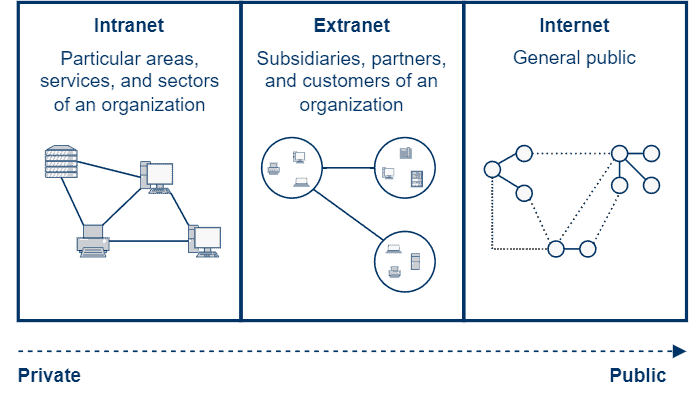1. 简介
网络的本质是通信。 计算机网络使得人类能够在全球范围内快速高效地交流信息。其中,互联网(Internet)构成了一个全球性的网络,让这一切成为可能。
但网络通信并不一定依赖于互联网。我们也可以构建私有环境下的网络,例如内网(Intranet)和外网(Extranet)。
本文将介绍 Internet、Intranet 和 Extranet 的定义与区别,帮助我们理解它们之间的关系。 我们会先简要回顾网络基础,然后分别介绍 Internet、Intranet 和 Extranet 的特点,最后通过表格和图示进行对比总结。
2. 网络基础
网络的核心功能是设备之间的数据交换。网络不是单一结构,而是根据用途、规模、拓扑等被分为多种类型。
比如,按设备连接拓扑可分为总线型、环形、星型、网状等。大型网络也可以混合使用多种拓扑,形成复合型网络结构。
另外,网络还可以从物理基础设施(underlay)和逻辑连接(overlay)两个层面来分析。底层网络(underlay)可能使用传统物理设备,也可能使用虚拟化技术(如 NFV、SDN)。
在众多网络分类方式中,有一种是根据网络的访问范围来划分的 —— Internet、Intranet 和 Extranet 就属于这种分类。它们在访问权限和安全要求上存在显著差异。
3. 互联网(Internet)
互联网是一个全球性网络。 它由遍布全球的设备组成,通过有线或无线方式传输数据,实现全球通信。
互联网内容丰富、公开,任何人都可以通过合适设备接入。它没有明确的所有者,也没有统一的访问控制策略。
尽管互联网开放自由,但也因此带来了不少挑战:
✅ 优点:
- 全球可达,信息丰富
- 无需特定权限即可访问
❌ 缺点:
- 安全性差,需用户自行防护(如加密通信、防火墙、杀毒软件等)
- 竞争激烈,信息真假难辨
4. 内网(Intranet)
内网是一个组织内部使用的私有网络。 通常用于公司或机构内部通信与数据交换,例如员工之间的文件共享、内部系统访问等。
由于访问范围受限,内网可以实施严格的访问控制和安全策略,例如:
- 多因素认证
- 防火墙
- DMZ 架构(隔离敏感服务)
✅ 优点:
- 通信高效,提升员工协作效率
- 成本可控(中长期)
- 独立于第三方通信基础设施
❌ 缺点:
- 初期部署成本高
- 需要专业团队维护
5. 外网(Extranet)
外网是内网的延伸,用于连接多个组织之间的可信网络。 通常用于企业与合作伙伴、供应商或客户之间的安全通信。
外网的核心目标是实现组织间的安全协作和资源共享,例如客户自助服务平台。
✅ 优点:
- 数据高度安全
- 业务流程自动化
- 提升客户满意度
❌ 缺点:
- 实施和维护成本高
- 用户越多,安全管理越复杂
- 需要跨组织的安全策略协调(如使用 VPN)
6. 对比总结
我们可以从多个维度对 Internet、Intranet 和 Extranet 进行对比:
| 属性 | Internet | Intranet | Extranet |
|---|---|---|---|
| 可访问性 | 公共 | 私有(组织内部) | 私有(组织+可信方) |
| 覆盖范围 | 全球 | 组织内部 | 多组织间 |
| 管理控制 | 无统一管理 | 组织内部管理 | 多方协议共同管理 |
| 安全机制 | 用户自保 | 防火墙等 | 防火墙 + VPN 等 |
| 网络关系 | 基础网络 | 基于 Internet 构建 | 基于 Intranet 扩展 |
下图展示了三者之间的关系:

从图中可以看出:
- Internet 是最开放、最广泛的网络
- Intranet 是最封闭的私有网络
- Extranet 是 Intranet 的安全扩展,连接多个组织
7. 总结
本文系统介绍了 Internet、Intranet 和 Extranet 的定义、特点与差异。
✅ 总结要点:
- Internet 是全球开放网络,自由但不安全
- Intranet 是组织内部私有网络,安全可控但部署维护成本高
- Extranet 是 Intranet 的扩展,用于跨组织通信,安全要求更高
通过这些网络分类,组织可以更好地规划通信架构、制定安全策略,既保障数据安全,又提升协作效率。